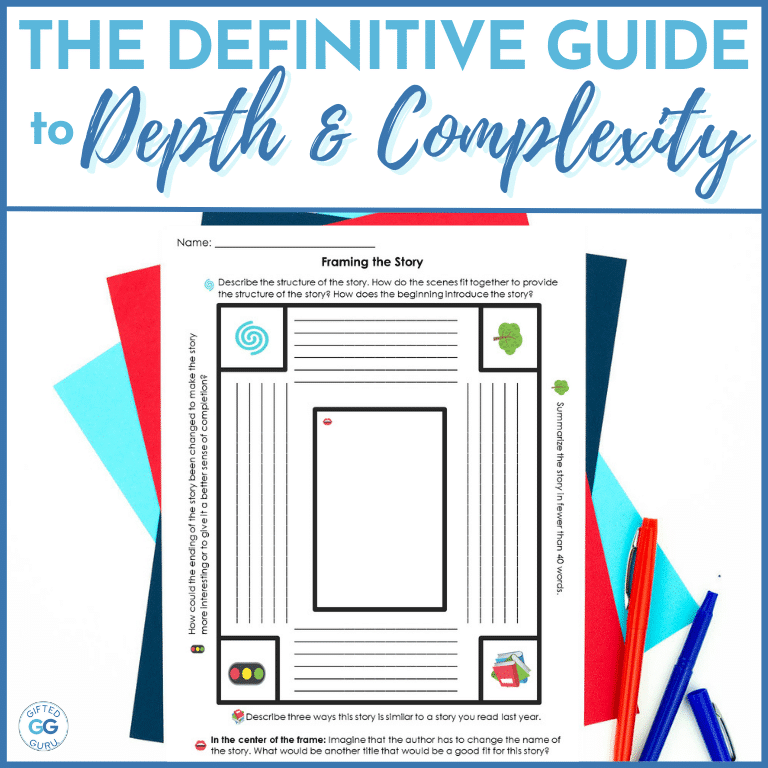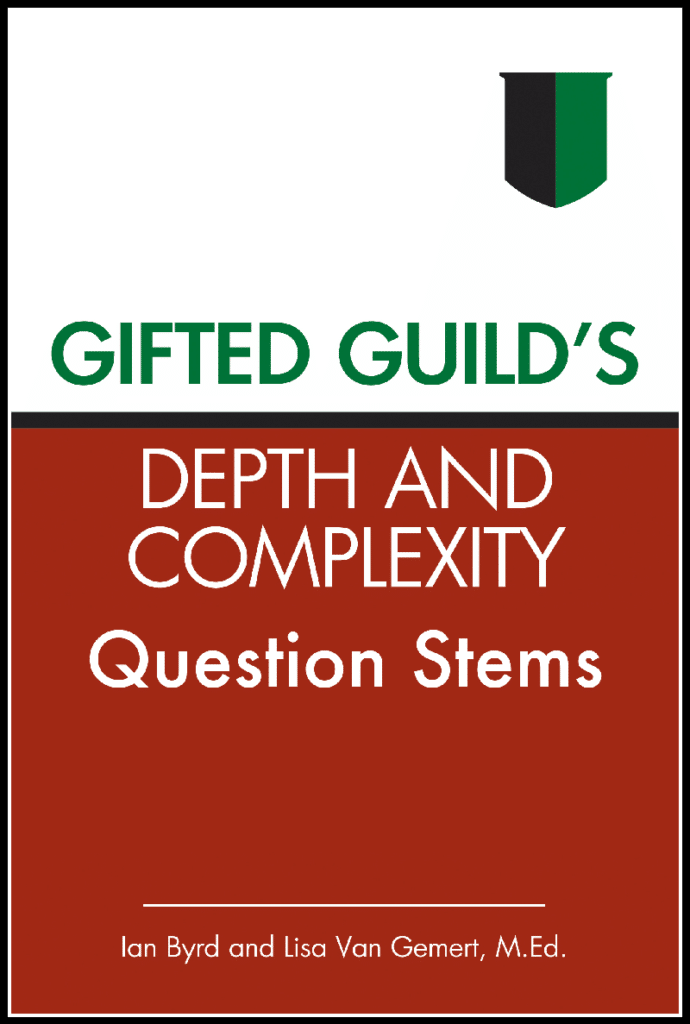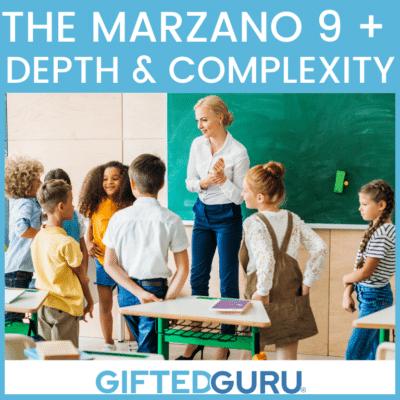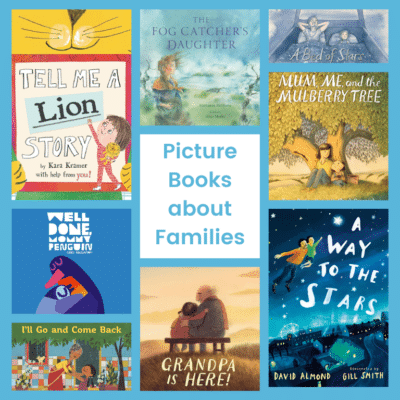Most people have something they say they’d run back into a burning house for. For some, it’s photos or mementos. For others, it’s something of great monetary value.
As a teacher, I have a few pedagogical tools I’d (figuratively) run into a burning house for, and the most precious is the Depth & Complexity framework. I’ve written a book about it with Ian Byrd, but this introduction to Depth and Complexity should get you started!
What is Depth and Complexity?
The Depth and Complexity framework is a set of tools that allow teachers to differentiate for any grade level or content area in a way that is straightforward to implement and effective. It is composed of eleven elements represented by a set of icons or pictures.
The Depth and Complexity framework is primarily a differentiation tool. It adjusts how students approach the content they are learning about. In addition to the eleven elements, Depth and Complexity has other components that teachers use to raise the thinking level in the classroom.
If you’d like to watch a video introduction to Depth and Complexity, you can watch that here.
Why is Depth and Complexity so valuable for teachers?
Depth and Complexity works. It was designed to raise thinking levels of gifted students in a general education classroom, and it goes above and beyond that.
In the often chaotic world of education where theories and ideas and methods fall in and out of favor, Depth and Complexity has quietly continued being an effective, inexpensive, quality tool any educator can use.
Developed by Bette Gould and Sandra Kaplan, the Depth and Complexity framework is composed of six fundamental elements that work together to allow any teacher or any content area or grade level to raise student achievement and differentiate instruction painlessly.
It’s the one thing that always works for me, no matter what I’m being asked to do (think miracles of pedagogical finesse).
What are the Icons of Depth and Complexity?
The most recognizable part of the Depth and Complexity framework is the set of eleven icons that represent the eleven thinking prompts.
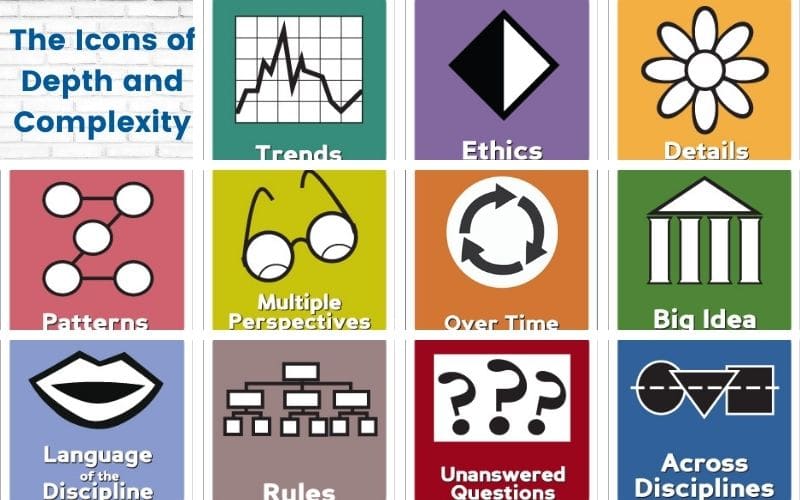
The eleven elements are divided into two types: depth and complexity.
The eight Depth elements are:
- Language of the Discipline
- Details
- Patterns
- Unanswered Questions
- Rules
- Trends
- Ethics
- Big Idea
The three Complexity elements are:
- Across Disciplines
- Multiple Perspectives
- Change over Time
They are each a lens through which we look at content or ideas. Humans are visual creatures by nature, and the use of the pictures signals the brain, paving the way for the thinking that is to follow.
Because they remain the same through all grade levels and content areas, they give students and teachers a common vocabulary and common understanding of what kind of thinking will be used in any learning opportunity.
This commonality saves time and mental energy, two things in short supply in today’s classroom.
The icons are copyrighted by JTaylorEducation, and they are free for classroom or personal use.
What are the Other Parts of the Depth and Complexity Framework?
While most people associate Depth and Complexity with its icons, the framework is far more than just pictures.
It encompasses the ideas of:
- disciplinarianism
- scholarly traits
- universal concepts
- Content Imperatives
- varied thinking skills
- elements (icons)
Like many games of strategy, Depth and Complexity is something that can be learned quickly and mastered over long periods of time. A teacher can begin incorporating Depth and Complexity into a classroom very quickly, and then deepen that practice for the rest of his or her career.
Using the Elements: Language of the Discipline
Let’s look at a couple of the elements to get an idea of how you can use them.
First let’s explore Language of the Discipline.
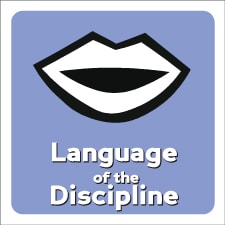
I want to start with this because I believe that academic vocabulary is the key to success in virtually every content area.
Too many students are being asked to think critically while they lack fundamental skills in the language of the content. This element, represented by lips on a lavender background, is the lens of language.
What words are associated with this content?
What vocabulary do you need to know to work with this content?
What are the phrases, signs, symbols, abbreviations, or figures of speech you need to understand to work effectively in this content?
It also includes tools, like protractors or Bunsen burners.
Teachers can use the Language of the Discipline element to cue students that this is a key word, label anchor charts or KWL charts, open up a discussion about a new topic by introducing unfamiliar vocabulary, or a host of other ideas.
A simple example of its use would be a high school biology teacher who might have a diagram of a cell that students are to label. The teacher could put the Language of the Discipline icon on the diagram to signal students that they’re going to use the formal academic vocabulary to label the diagram.
The same element could be used differently with the same content, taking advanced students deeper.
Instead of labeling the diagram, students could categorize the words related to the cell’s structure and then research the etymology of those words. In this instance, nucleus, nucleolus, and nuclear membrane all arise from the Latin nux, meaning “kernel” or “inner part.”
Using the Elements: Multiple Perspectives
Let’s take another example using a Complexity element this time.
Multiple Perspectives is represented by a pair of glasses on a chartreuse background.
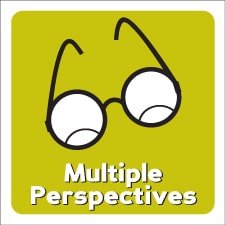
This element is one of my particular favorites because helping students see things from multiple perspectives and recognize that one’s perspective strongly influences one’s view of something is perhaps the greatest intellectual deficit of our time.
Multiple Perspectives plays well with others, combining well with other elements of the Framework. We can put Multiple Perspectives together with Language of the Discipline to arrive at some very deep thinking.
Imagine this same high school biology teacher wants to provide an opportunity for students to continue to work with the Language of the Discipline of the parts of the cell. The teacher could ask students to make a chart with the name scientists have given the parts of the cell in one column, then create another column with what political scientists might call that same structure, and yet another column with what the cell itself might call the structure.
Wrapping Up
In simple exercises like this, the power of Depth and Complexity reveals itself. The same content and the same element allow for varying degrees of difficulty and engagement.
A teacher does not need to use all eleven of the icons nor all six of the aspects of the framework in order to begin implementing it in class.
Start small. Take one element and try it out. Keep an eye out for opportunities to learn more.
You’ll soon find that Depth and Complexity framework becomes an essential part of your teaching toolbox. I’m not promising that you’ll run back into a burning house for it, but I do promise that you’ll find it to be extraordinarily useful to you in whatever path your teaching career takes you.
Find Depth and Complexity resources at the following places:
- You can find everything I’ve written on the website on Depth & Complexity by looking at the Category “Depth & Complexity.”
- If you want to become a Depth and Complexity master, you can take the Depth and Complexity Course. Learn more here.
The Essential Guide
Ian Byrd and I wrote an entire book on Depth and Complexity, and at the risk of sounding obnoxious, it’s really, really good. You can get it in print or ebook format, and I promise it’s worth it. Get your copy here.
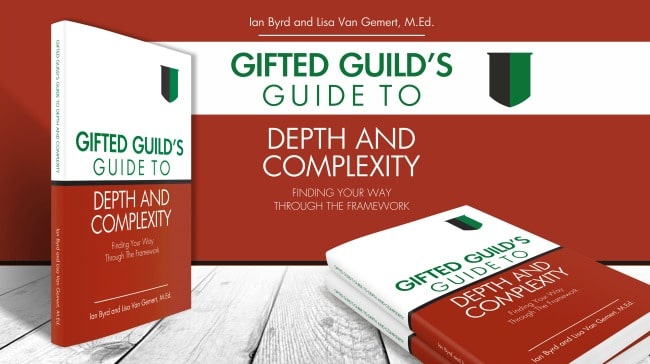
You can also get a convenient ebook with all of the question stems. It’s got hundreds of questions divided by content area, and is very useful.
Learn more about it here, or get your copy here.
You may also like:
- Depth & Complexity Rules Cards
- Depth & Complexity Frames
- Are You Making this Depth and Complexity Mistake?
Note: I first wrote a version of this piece when I was keynoting the Kentucky Association for Gifted Education conference and they asked for an article for their newsletter. If you’ve read it before, hello, Kentucky friends!


